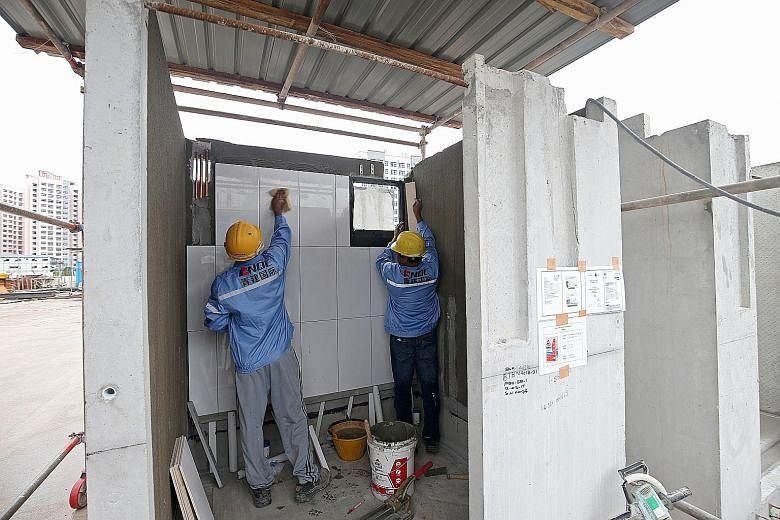Pre-fabricating rooms and bathrooms off-site promises not only manpower savings and faster assembly, but also better quality for HDB home owners.
But yesterday's announcement that the Housing Board is targeting the use of more pre-fabricated units for launches from 2019 onwards has left some home owners wondering if the construction method will live up to expectations.
Housewife Dion Lim, 38, for one, was unhappy with the bathrooms in her Fernvale Lea flat - the first Build-to-Order project to feature pre-fabricated bathroom units.
The Sengkang project was completed in January last year. Since then, pre-fabricated bathrooms have been installed in about 14,000 units over 15 projects islandwide.
Madam Lim said that problems included uneven tiles, loose fittings and rusty doors. It is not clear if these are necessarily due to the bathroom being pre-fabricated, but she said: "I thought that these being prepared in a factory meant that there wouldn't be these problems."
She later either rectified them on her own or ignored them.
The technology used to make pre-fabricated units has improved over the years, said Nanyang Technological University engineering professor Robert Tiong.
"Traditionally, pre-fab items were fitted after the building was completed. Now, all the pre-fab units, such as toilets, can be assembled at the same factory with the same pool of labour and expertise, while saving on time, logistics and transportation."
He added: "It will be easier to manage and ensure good quality, since the inspection can be done at the factory as soon as the unit is completed."
At the same time, said BHCC Construction quantity surveyor Pan Zhi Hua, quality will improve as those in the industry get more accustomed to the new methods.
Her company has not yet used the Prefabricated Prefinished Volumetric Construction (PPVC) method - where entire rooms are constructed fitted with flooring, wall finishes, window frames and paint in a factory, before being transported to the construction site - but it has several upcoming projects where the method will be used.
"After two or three projects, we'll have the experience to install all these extra efficiently and properly," she said.
As for the longstanding complaint that pre-fabricated units, with their blocky, modular designs, may make for boring buildings, Prof Tiong said a combination of new building materials and methods can help to spice things up.
Architect Calvin Chua said that HDB's adoption of the PPVC method, coupled with last week's news that structural walls in future flats could be pushed to the side, will give home owners a "flexible empty shell to customise their living spaces".
HDB yesterday also promised better homes with new materials.
These include vinyl strip flooring to replace floor tiles in bedrooms, which can be installed easily on site or off, and also offers better slip resistance.
Another example is unplasticised polyvinyl chloride skirting, which replaces traditional timber ones. The latter are supposed to be of better quality and can be installed more quickly, said HDB.




